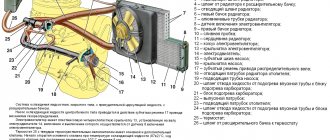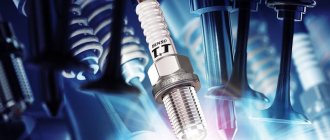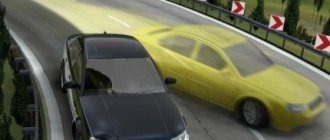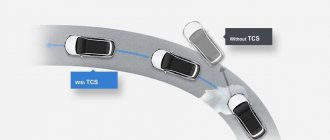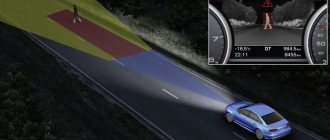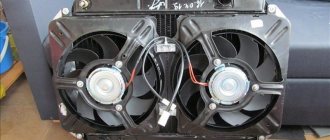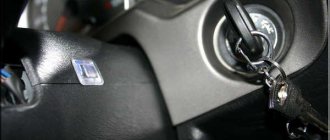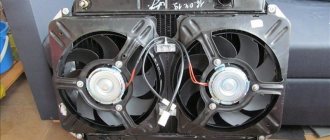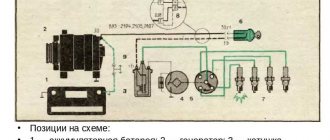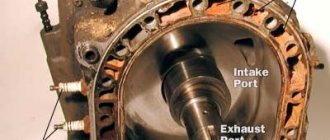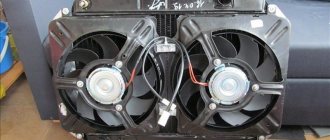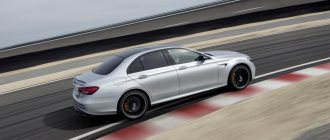The equipment of a modern car makes the driving process simple. At the same time, one cannot say that this is too easy. It is necessary to take into account many nuances in order not to end up on the sidelines not only of the road, but also of life. Road curves, weather conditions, driving experience and much more are important. The car can behave unpredictably on the road. Loss of control can cause an accident. How to prevent such developments?
This can be done using ESP. This abbreviation hides a system that provides directional stability. From the perspective of the English language it stands for: Electronic Stability Program.
What is ESP
It refers to a security system that uses a computer to control the car in unusual situations. If the car loses stability on the road, that is, it begins to follow a dangerous trajectory, then its position is forcibly leveled.
ESP is not a uniform designation for dynamic stabilization systems. This is a popular brand and nothing more. Therefore, we will consider it specifically. Although other similar systems have their own popularity, for example, ESC and DSC.
Advantages and disadvantages
All the advantages of the system are clear from the description of its actions in critical situations. She will save the car when nothing else can help it.
Moreover, when driving fast, sometimes inexperienced drivers in independent tests were ahead of motorsports drivers who did not have such a system. You shouldn't hope for it, but ESP multiplies the driver's abilities, unless of course they are zero.
But unpleasant situations also happen.
- In the most severe cases, ESP is ineffective, the wheels no longer have grip on the road, and it is not trained in non-standard techniques of an experienced driver.
- Engine traction control algorithms are still poorly developed, especially adding it to front-wheel drive and all-wheel drive vehicles. Although for those same motorsports athletes these are the basics, without which they have nothing to do on the road. But such techniques are difficult to automate.
- Sometimes the system misunderstands the chaotic rotation of the steering wheel by an inexperienced driver. According to the logic of security inherent in it, to put it simply, it must obey a person whose abilities are unknown to it. Therefore, ESP does not yet have the right to act radically by removing him from control.
To combat shortcomings, there is one remedy - the ESP disable button, available on many cars. It should be used only when the consequences are precisely known.
Although the system does not completely turn off in this case, the threshold for its intervention is simply significantly reduced.
Story
The first patent for a system of this type was issued in 1959. The development was called “Control Device”. It was initiated by the Daimler-Benz concern. The result was mediocre. The concern's engineers were unable to offer a product that could become a real driver's assistant.
Everything changed after many years. In 1994, premium Mercedes were equipped with a full-fledged security system. Somewhat later, exchange rate stabilization became available on production vehicles from Mercedes-Benz.
Is electronic stability control necessary?
Data and statistics support the benefits of having ESC in vehicles and preventing accidents. Active safety technology such as ESC, according to Road Safety Fact.eu, "can prevent accidents entirely, or at least actively help the driver reduce the impact of an emergency situation" .
One regularly cited study from Loughborough University shows that the risk of being involved in an accident has decreased by 25%. Other research suggests that ESC is more effective in reducing some types of multiple crashes.
Device
By itself, ESP is not capable of performing the tasks assigned to it. Electronic sensors are required to help. A special unit processes the signals coming from them. The electronics promptly inform the system about the vehicle’s inappropriate behavior, which makes it possible to regain control of the vehicle.
The list of constituent elements is formed by:
- the main unit, designed to process signals from sensors and control specific devices;
- sensors that record how fast each wheel rotates;
- sensors that measure the speed and axial deviation of the vehicle. Sensors of this type are located inside one housing;
- a controller capable of determining how the steering wheel changes its angle of rotation;
- hydraulic unit that initiates braking forces.
Assistants also include the following systems:
- ABS – eliminates the possibility of wheel locking during braking;
- EBD – force distribution when controlling brake discs;
- ASR – control of how much the wheels slip, followed by redistribution of torque. Slipping is eliminated;
- EDS is an addition to ASR. Blocking of the differential mechanism.
Malfunctions
Since ESP is based on all the main components of the anti-lock braking system, its malfunctions are also related to them. Violations in the operation of the program itself are unlikely.
- Most often, wheel rotation sensors and their wiring fail, since they work in the most difficult conditions.
- Problems may be related to the hydraulic unit, its pump and valves. Especially if you neglect the scheduled brake fluid replacement.
- All other sensors fail no more often than any other electronics; natural aging of components, moisture and corrosion can be the reasons. As always, pay special attention to the wiring.
In the event of a failure, the self-diagnosis system will illuminate the corresponding lamp on the instrument panel. Driving without ESP is very undesirable, the behavior of the car will become unusual, and with the most powerful engines the driver may simply not be able to control it.
How it works
Exchange rate stabilization via ESP is not possible without ABS. The anti-lock braking system is an important point in adjusting the behavior of the car. The stabilization process is also ensured through the functionality of the traction control system and a unit capable of changing the engine operating mode.
ESP determines the development of skidding using several parameters. For example, at a small angle of rotation of the wheels, an excess of lateral acceleration and a significant change in the angle of rotation of the vehicle may be recorded. This goes beyond “driving properly,” so the system comes into play.
In practice, specific wheels slow down or the braking force weakens. The hydraulic modulator changes the state of the brake system in terms of its pressure. The operation of the power unit is being adjusted. The controller unit reduces the fuel supply, which reduces the torque transmitted to the wheels. As a result, the car is given its previous trajectory.
The structure has a main block that receives and processes information coming from sensors. This information means several points: at what speed the wheels rotate, in what position the steering wheel is and how much pressure in the brake system corresponds to the norm. Based on such data, ESP decides how to act. In this case, the most important signals are from two sensors that read lateral acceleration and angular velocity.
Let's look at an example of a simplified diagram of how exchange rate stabilization occurs.
Skid
The block controller receives data:
- the rear axle begins to shift in the direction it is skidding;
- the sliding speed is outside the permissible limits.
If you are an experienced driver, then step on the gas and try to get out of the skid. The key word here is “experienced,” but the majority of people driving are those who have not been in similar situations. They may get confused. Inattention is also something to consider. This is where the need for ESP comes into play.
The system returns the car to its previous course by braking the front wheel from the outside.
Demolition
Sensors signal unusual behavior of the vehicle:
- the displacement of the front axle is recorded in a direction such as the outer side of the turn;
- The yaw rate is determined to be low.
The system stabilizes the car, which is achieved by braking the rear wheel from the inside.
Why do they turn off stabilization?
They have a lot of names: ESP, DSC, ASC, VSC... They are manufactured by different companies and have different software, differ in functions, capabilities and generations. But the average car enthusiast only needs to know one thing about them - if the car has electronics that control directional or dynamic stability, it is better not to simply turn it off. In the vast majority of driving situations, stability control programs intervene to the point and are very effective.
The systems are usually designed for drivers with little experience. In dangerous situations, a person does not always maintain composure for quick and correct actions, and sometimes he even panics, feeling a drift or skidding, and does exactly what is not necessary. This is when the electronics help to avoid inevitable disaster by reducing the thrust supplied from the engine and braking individual wheels so that the car does not begin to spin around a vertical axis and, if possible, follows the correct trajectory.
The key word is “if possible.” Even the most advanced ESP cannot overcome the laws of physics. If, for example, the road is too slippery, and the driver greatly miscalculated the speed, then the program will, at best, reduce the consequences of the error, but will not add much to the chances of staying on the road.
Off-road, standard road stabilization algorithms can throw up a completely unpleasant surprise. A typical case is a deep, unsteady rut in the mud. Such a section can only be passed under traction, with wheels slipping, regardless of how the car rushes to the sides. But vigilant electronics can mistakenly recognize an emergency situation, limit engine thrust and thereby “land” the car in the most inappropriate place.
To avoid such embarrassments, the treasured ESP deactivation button was invented. On many cars it has two stages of operation. When you press the program icon key once, a yellow icon with zigzag tracks lights up on the dashboard. Only the part responsible for traction correction is turned off. The “shackles” are removed from the gas pedal, and the program will resolve slipping, while continuing to monitor the car’s behavior in corners. If a skid develops, she will still intervene. This algorithm can be useful on the race track for sporty driving. The mode is unsafe for normal street conditions.
When you press the button a second time, the electronics can be turned off completely (for some systems, the same ESP Off mode is activated by a long press). This is where it can come in handy for short off-road trips.
In general, disabling ESP is always a risk. Fortunately, progress does not stand still, and manufacturers are trying to develop smart stabilization systems that do not need to be turned off at all. In modern crossovers, they are already complemented by “behavioral” driving programs for various conditions and surfaces - for example, for grass and dirt, gravel or large stones, sand or snow. And the most advanced SUVs themselves select the best algorithm for off-road conditions, without requiring any preliminary actions from the driver at all.
The same applies to powerful cars and sports cars. Advanced electronics monitor not only the dynamics and course of movement, but also analyzes a person’s driving style and adapts to his control style, helping to “pull” the car into a turn, get out of a turn on the verge of slipping with a slight skid, etc. And the more expensive the car , the faster you forget where the ESP deactivation button is located.
Conclusion
Some car enthusiasts believe that ESP is an obstacle to normal driving and the impossibility of getting out of critical situations. The last statement is true, but partly. The percentage of inappropriate ESP behavior is negligible.
The system that provides directional stability is effective. It does not allow drivers to behave too freely on the road. Driving attempts that go beyond what is permitted are stopped. The loss of power on slippery surfaces in off-road conditions is covered by electronic imitation of blocking, which helps to overcome obstacles when diagonal hanging occurs.
1-UBK-20781
Redundant system architecture
The car will soon become much safer; like modern aircraft, it will have various systems that duplicate each other. This is, first of all, necessary to ensure that a sudden failure of one of the systems does not lead to an accident.
Bosch specialists have already developed backup brake system technology. The electromechanical brake booster iBooster and ESP (electronic stability control) allow you to stop the car independently of each other.
Highly accurate map data
Now the positioning accuracy of modern navigation systems is within one meter. For a safe autopilot, the accuracy must be increased at least ten times. In addition, maps should be updated more often. Our habit of installing new signs while the road is being repaired, and then forgetting to remove them, can drive the car’s cybernetic brain crazy. For example, when the video camera detects a “brick” and the navigation determines the road as one-way. Where should we go then? After all, the ban on violating traffic rules will be the main one for artificial intelligence.
We have listed only three problems, while there are dozens of them on the way to creating an autopilot! And yet there is hope that in ten years we will be able to go to the dacha early in the morning in a “smart” car, and on the way sleep peacefully in the driver’s seat.
ESP system: where are we heading?
What are the benefits of electronic stability control?
Many studies have been conducted to determine the effectiveness of the stability control system.
According to the European Road Safety Observatory (ERSO), vehicles with ESC:
- 22% less likely to get into an accident.
- You are up to 38% less likely to be involved in an accident due to wet or snowy roads.
- The likelihood of rollover is reduced by 59% - and this is more than 67% for SUVs.
- 33% less likely to skid.
Due to its high efficiency and benefits for drivers, the European New Car Assessment Program (Euro NCAP) added ESC to its safety tests in 2009.
This means that vehicles not equipped with ESC cannot achieve the highest 5-star safety rating.
Indirect signs of the cause of the breakdown
- incorrect operation of the rear brake lights at the same time as the EPS sign is on indicates that it is necessary to check the brake pedal sensor,
- If there is a voltage drop, you need to check the fuse,
- if any repair work was carried out before the light began to light up, then examine the sensors and wires at the place of repair work.
If there are no such clues, then the problem can only be identified using a scanner.
You can drive for a long time with a faulty stabilization system, but the safety of the car's passengers is at risk, and the cost of the issue may be scanty.
